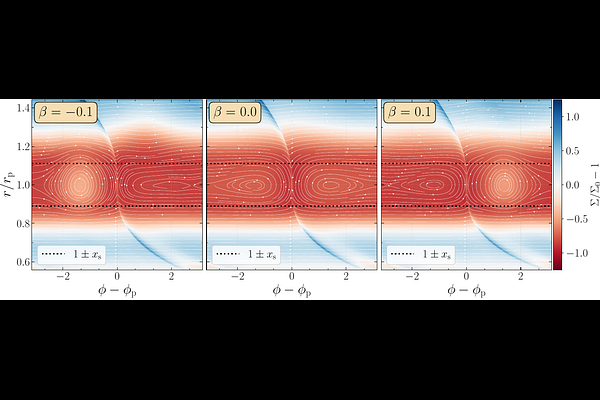Origin of the asymmetric gas distribution near the co-orbital Lagrange points of an embedded planet

Origin of the asymmetric gas distribution near the co-orbital Lagrange points of an embedded planet
Agustin Heron, Cristobal Petrovich, Pablo Benítez-Llambay, Juan Garrido-Deutelmoser
AbstractHydrodynamic simulations of planet-disk interactions often show material accumulation near the co-orbital Lagrange points $L_4$ and $L_5$ -- features that may correspond to observed crescents in protoplanetary disks. Intriguingly, these simulations also show an asymmetrical distribution of gas between $L_4$ and $L_5$, whose physical origin is not yet understood and could allow to further constrain the inner workings of planet-disk interactions. We performed 2D hydrodynamic simulations of a single, non-migrating planet embedded in a gaseous disk to investigate this effect. We find that the asymmetry is solely controlled by the sign of the radial temperature gradient with positive gradients enhancing the accumulation at $L_4$ and negative ones enhancing $L_5$. A symmetric distribution is recovered on globally isothermal disks. Furthermore, we find that the azimuthal locations of $L_4$ and $L_5$ deviate from the classical circular restricted three-body problem, following a monotonic trend with the disk pressure scale height $h_{\rm p}$: $\phi_{\text{max}}\approx\pm60^{\circ}[1+0.18(h_{\rm p}^3M_\star/m_{\rm p})^{2/3}]$. Our simulations show that the longest-lived and largest-amplitude structures are produced by planets opening gaps with depths $\Sigma_{\rm gap}/\Sigma_0\lesssim 0.2$. We successfully reproduce the observed asymmetry using a semi-analytical model that incorporates the azimuthally asymmetric radial velocity background induced by the planet. Overall, our results suggest that asymmetries in the form of crescents and clumps inside of density gaps opened by planets can constrain the local thermodynamic properties of protoplanetary disks.